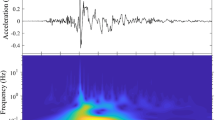Abstract
In a continuous GPS deformation monitoring scheme, any action taken generally relies on a description of the state of the process or events as given by GPS measurements. Timely and correct interpretation of the GPS data is essential to improved quality control, safer system operations, and reduction in the number of false alarms. Unfortunately, GPS data are contaminated by both random and systematic errors of unknown sources. Instrument failure, poor or uncalibrated instrumentation, receiver noise and multipath, all can contribute to data problems. Without proper pretreatment, the necessary interpretation is difficult, if not impossible. Data contaminated by outliers must be eliminated and noise levels reduced. In many cases, critical information occurs over a short duration, and hence is difficult to detect. Wavelets can be used to pre-process data in order to better locate and identify significant events. Combining this type of data pre-processing with multivariate statistics can generate useful insights into the problems of deformation monitoring, data analysis and data interpretation.
Multivariate techniques can be used to identify process variability and to develop models for online monitoring and control. By comparing new observations with a reference model that describes normal variability, simple control charts can be constructed to detect data inconsistencies and processing problems. This paper extends these concepts by demonstrating that correlated output of multiple sensors such as GPS receivers, accelerometers, anemometers or temperature sensors can be significantly improved with pre-filtering of the time series signals using a median filter, and a time-scale decomposition using a multi-resolution wavelet function. After the data are filtered and decomposed, the multivariate statistical method of Principal Component Analysis is used to develop a deformation monitoring model.
Access this chapter
Tax calculation will be finalised at checkout
Purchases are for personal use only
Preview
Unable to display preview. Download preview PDF.
Similar content being viewed by others
References
Chui, C. K. (1992). An Introduction to Wavelets. Academic Press, New York.
Dunia, R., S.J. Qin, T.F. Edgar & T.J. McAvoy (1996). Identification of faulty sensors using principal component analysis. AIChE J., 42, 2797–2812.
Heinonen, P., & Y. Neuvo (1987). Fir-median hybrid filters. IEEE Trans. Acoustics, Speech & Signal Processes, 35, 832–838.
Jackson, J.E. (1980). Principal components and factor analysis: Part 1— principal components. Journal of Quality Tec hnol ogy, 12, 201–213.
Ogaja, C., C. Rizos, J. Wang, & J. Brownjohn (2001a). High precision dynamic GPS system for on-line structural monitoring. 5th Int. Symp. on Satellite Navigation Technology & Applications, Canberra, Australia, 24–27 July, paper 35, CD-ROM Proc.
Ogaja, C., J. Wang, C. Rizos & J. Brownjohn (2001b). Multivariate monitoring with GPS observations and auxiliary multi-sensor data. To he published in GPS Solutions.
Olivier, R. & M. Vetterli (1991). Wavelets and signal processing, IEEE Sig. Processing, October, 14–38.
Roberts, G.W., X. Meng & A.H. Dodson (2000). Structural dynamic and deflection monitoring using integrated GPS and triaxial accelerometers. 13th Int. Tech. Meeting ofthe Satellite Division ofthe U.S. Inst. ofNavigation GPS ION 2000, Salt Lake City, Utah, 19–22 September, 59–68.
Wang, Y. (1995). Jump and sharp cusp detection by wavelets. Biometrika, 82, 2, 385–397.
Author information
Authors and Affiliations
Editor information
Editors and Affiliations
Rights and permissions
Copyright information
© 2002 Springer-Verlag Berlin Heidelberg
About this paper
Cite this paper
Ogaja, C., Wang, J., Rizos, C. (2002). Principal Component Analysis of Wavelet Transformed GPS Data for Deformation Monitoring. In: Ádám, J., Schwarz, KP. (eds) Vistas for Geodesy in the New Millennium. International Association of Geodesy Symposia, vol 125. Springer, Berlin, Heidelberg. https://doi.org/10.1007/978-3-662-04709-5_56
Download citation
DOI: https://doi.org/10.1007/978-3-662-04709-5_56
Publisher Name: Springer, Berlin, Heidelberg
Print ISBN: 978-3-642-07791-3
Online ISBN: 978-3-662-04709-5
eBook Packages: Springer Book Archive




